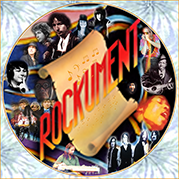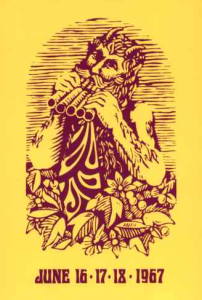 A collection of songs from the time of Monterey Pop in 1967
A collection of songs from the time of Monterey Pop in 1967
The Monterey International Pop Festival, June 16-18, 1967, was the melting pot that merged rock ‘n’ roll, pop, psychedelic music, folk, and elements of rhythm & blues, country blues, country/western, jazz, and even world music, into what we now call rock.
Monterey Pop, the film by D.A. Pennebaker, is one of the 10 best rockumentaries of all time and a pivotal moment in the history of rock music. It is available on DVD as The Complete Monterey Pop Festival-Criterion Collection, which includes the film by D.A. Pennebaker, outtakes, and other selections. Watching it a few years after it came out, some time in the early 1970s, the film steered me right back into examining the origins of rock music. “You know, I’ve heard some of these bands,” says a fan in the beginning of the film, “but to here all of these bands at the same time, that’s gonna be too much…”
“And so the Monterey Pop Festival became the first powwow of the Love Crowd, the perfect pastorale, chocked with music and warmhearted people. Its success was so unprecedented that it took everyone by surprise. You see, at the beginning nobody was sure that the Love Crowd was out there.” — Robert Christgau, Esquire, Jan. 1968.
Scenes from Monterey Pop
The film shows the flower children arriving and partying with a free abandon that presaged Woodstock by two years. The day-glo painted Prankster bus was there. Who can forget the young fan with the American flag painted on his bald head? Michelle Phillips of the Mamas and Papas holding on the phone for Dionne Warwick. Monterey’s finest in law enforcement, wearing riot helmets, smiling and milling about with nothing to do. Mama Cass Eliot in the front row gasping with astonishment over Janis Joplin’s performance. Mickey Dolenz of the Monkees leading the cheer for Ravi Shankar, after Mike Bloomfield knelt in rapt attention at his feet. White suburban kids in sunglasses and flower print dresses and bleached blonde hair, grooving to the earthy blues of Canned Heat and Paul Butterfield.
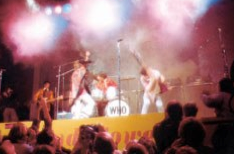 Many legends of rock held their debut performances there, in front of an international audience, including Janis Joplin (who had not been heard outside San Francisco), the Who and Jimi Hendrix (who had been heard only in England at that time), and the San Francisco psychedelic pioneers (Jefferson Airplane, Grateful Dead, Big Brother and the Holding Company, Country Joe and the Fish, even Moby Grape). The festival also featured artists that were already popular, from the Swinging London-based Animals to the Los Angeles-based Byrds, and icons of the pop music world including Simon & Garfunkel, the Mamas and the Papas, and Otis Redding. Brian Jones of the Rolling Stones was on hand to be MC. All of pop royalty were involved, including the Beatles, which donated equipment. In fact, Paul McCartney, as a board member of the concert, had recommended the Jimi Hendrix Experience.
Many legends of rock held their debut performances there, in front of an international audience, including Janis Joplin (who had not been heard outside San Francisco), the Who and Jimi Hendrix (who had been heard only in England at that time), and the San Francisco psychedelic pioneers (Jefferson Airplane, Grateful Dead, Big Brother and the Holding Company, Country Joe and the Fish, even Moby Grape). The festival also featured artists that were already popular, from the Swinging London-based Animals to the Los Angeles-based Byrds, and icons of the pop music world including Simon & Garfunkel, the Mamas and the Papas, and Otis Redding. Brian Jones of the Rolling Stones was on hand to be MC. All of pop royalty were involved, including the Beatles, which donated equipment. In fact, Paul McCartney, as a board member of the concert, had recommended the Jimi Hendrix Experience.
Songs You Would Have Heard on the Way to the Festival…
The Rockument show includes the original versions of pop songs by artists that appeared at Monterey. Many of these songs were performed live. While the live versions are historical and interesting, they are not, in my opinion, the best versions to listen to.
The purpose of this show is to highlight the pop songs of that period and point you to the released versions, which were playing on the radio and in people’s heads as they arrived and departed Monterey. The show reflects the expectations of the festival-goers, what songs they were already familiar with, and how they would feel after the festival.
For the actual live festival versions, I recommend the box set, Monterey International Pop Festival [30th Anniversary Box Set].
“San Francisco (Be Sure to Wear Flowers in Your Hair)” (John Phillips), by Scott McKenzie
This song, written for the occasion of the Monterey International Pop Festival and used as the opening of D.A. Pennebaker’s film Monterey Pop, rose to #4 in the pop charts the week after the Festival. It was L.A.’s homage to S.F. written by John Phillips of the Mamas and Papas, played live at Monterey Pop (badly). This is the studio version. In this remastered version you can finally hear the background sitar and percussion instruments. The song features L.A. session heroes Joe Osborn on bass, Larry Knechtel on piano, and Hal Blaine on drums, with John Phillips on guitar. Scott McKenzie and John Phillips were in the folk trio the Journeymen before Scott started his solo career and John started the Mamas & Papas.
“So Sad About Us” (Peter Townshend) and “Happy Jack” (Peter Townshend) by the Who
The Who broke into the U.S. on the tour which included Monterey Pop. It was part of a second British invasion, one that would include hard rock, blues, and psychedelic music. After gaining a mod following in England and releasing two albums in the U.K., they toured the U.S. for the first time in early 1967. Monterey Pop was one of the stops on this tour. “So Sad About Us” and “Happy Jack” were among the first songs to be released in the U.S. on the album A Quick One (retitled in the U.S. as Happy Jack).
As the Who began the last song of their live act at Monterey, Pete Townshend spoke to the audience, “This is where it all ends.” The climax of the act included explosions and smoke, and Pete Townshend took a swipe at a microphone stand with his guitar, breaking its neck, then smashing his guitar to bits.
“Watching a rock band, you didn’t expect that to happen,” said Country Joe McDonald. “[Keith Moon’s] Drumsticks flying in the air, arms flying all over the place, microphone stands and equipment being thrown down — it was kind of a combination of wrestling and music.”
Henry Diltz, photographer: “Backstage, Townshend and Hendrix had been going back and forth about who should follow whom. John Phillips had finally resolved the issue by flipping a coin. The Who lost, which is why they came out and played with such a vengeance.”
Check out the Who official Web site.
“The 59th St. Bridge Song (Feelin’ Groovy)” (Paul Simon) by Simon & Garfunkel
Simon & Garfunkel were big-time folk stars about to switch to a more soft-rock format. They played this song at Monterey Pop, which was the duo’s most sugar-sweet pop song at that time, rather uncharacteristic of their usual songs of melancholy and anger.
“To me, the aspect of being ‘first’ about [Monterey] was performers were not getting paid — that was the key,” said Art Garfunkel. “It therefore showcased the fact that we were doing rock ‘n’ roll for the spirit of it, the love of being musicians out loud.”
Check out this fan site, Simon and Garfunkel-Song For The Asking, and Paul Simon’s site and Art Garfunkel’s site.
“For What It’s Worth” (Stephen Stills) by Buffalo Springfield
The song about a hippie riot on the Sunset Strip in Los Angeles in 1966. Stills was there with other notable L.A. freaks Peter Fonda and the members of the Byrds including David Crosby. A defining moment in pop music with protest themes. Who can ever forget Neil Young’s pinging guitar, a sonic signpost to a new form of rock music.
Buffalo Springfield’s lineup was, originally, Richie Furay (vocals, rhythm guitar), Dewey Martin (drums, vocals), Bruce Palmer (bass), Steve Stills (lead guitar, vocals), and Neil Young (lead guitar, vocals). Palmer eventually quit and was replaced by Jim Messina in mid-1967. Stills and Young would move on to form that famous combo Crosby, Stills, Nash & Young, and Richie Furay and Jim Messina would move on to found Poco.
For current information, see the official Crosby, Stills, Nash & Young site, and the official Crosby Stills & Nash site.
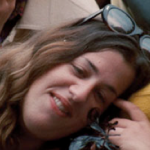 “Got a Feelin'” (Dennis Doherty/John Phillips) by The Mamas & The Papas
“Got a Feelin'” (Dennis Doherty/John Phillips) by The Mamas & The Papas
This is my favorite song of the Mamas and Papas, from If You Can Believe Your Eyes and Ears, showcasing their complex vocal harmonies and the strong leading vocals of Mama Cass (left) and Mama Michelle. Papa John Phillips was Monterey Pop’s organizer, along with their manager Lou Adler and ex-publicist Derek Taylor. The Mamas & Papas (John and Michelle Phillips, Cass Eliot, and Denny Doherty) headlined the event. “There was melody, there were lyrical moments, and beautiful — they looked so good together,” said Ravi Shankar. The song features L.A. session heroes Joe Osborn on bass, Larry Knechtel on piano, and Hal Blaine on drums, with John Phillips on guitar.
In the 1990s, the Mamas and Papas were fronted by Papa John Phillips with Scott McKenzie, but contained no other founding members.
“She Has Funny Cars” (Kaukonen/Balin) and “D.C.B.A.-25” (Kantner/Slick) by Jefferson Airplane
Jefferson Airplane were the most popular of the San Francisco Haight-Ashbury bands and the first to have a hit record. “She Has Funny Cars” was recorded in May 1967 at the Fillmore for the Surrealistic Pillow album, just before Monterey Pop. “D.C.B.A.-25” (also on that album) is a perfect blend of folk and psychedelic rock (“Too many days I’ve left unstoned”).
“They played with their backs to the audience as if they were loving their own light show,” said Art Garfunkel. “I just felt it was a good act to be so hang-loose about your audience that you didn’t even come to the lip of the stage and play for them.”
Check out the Jefferson Airplane official site.
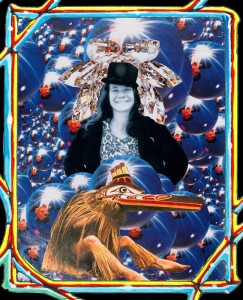 “Combination of the Two” (S. Andrew) by Big Brother & the Holding Company w/Janis Joplin
“Combination of the Two” (S. Andrew) by Big Brother & the Holding Company w/Janis Joplin
A live Big Brother track with Janis Joplin, introduced by Bill Graham at The Fillmore in San Francisco, from the Janis box set or the album Cheap Thrills. Monterey was the first time Big Brother had played outside the S.F. Bay Area. As the many biographies of Janis point out, she was much happier and far more creative when she worked with Big Brother, although her later solo songs were her most popular ones. D.A. Pennebaker used the live version of this song from the festival over the opening credits to the film Monterey Pop.
“Janis, as everybody knows, was the best girl blues singer we ever had,” said David Crosby. “She had more passion, sang with more abandon than anybody there.” Said concert organizer John Phillips of the Mamas and Papas, “When she came offstage, she was crying. She couldn’t believe she’d gone over so well. Janis stole the show.”
Check out the Big Brother & the Holding Company official site and the official Janis Joplin site.
“Mystery Train” (H. Parker/S. Phillips) by the Paul Butterfield Blues Band
The Paul Butterfield Blues Band, based in Chicago, brought the Chicago blues sound to pop music through the medium of rock ‘n’ roll, covering one of the songs that made Elvis famous. Paul Butterfield sang and played harmonica along with the incredible Mike Bloomfield on guitar, who left the band just prior to Monterey Pop but plays on this studio version. A young Elvin Bishop played rhythm guitar, with Jerome Arnold on bass, Sam Lay on drums, and a young Mark Naftalin on organ. This is the band that backed Bob Dylan when he first went electric at the Newport Folk Festival in 1965, when he faced the folk purists and turned up the amplifiers.
“Renaissance Fair” (David Crosby/Jim McGuinn) and “Have You Seen Her Face” (Chris Hillman) by the Byrds
The Byrds performed both these new songs at Monterey. At the time, the group was going through changes, moving from that jangly, psychedelic folk-rock sound (as in “Renaissance Fair”) to a new sound that would soon be called country rock (“Have You Seen Her Face”). “Renaissance” starts off with a warped, dissonant folky-psychedelic progression, which for me is part of the soundtrack of the Sixties Generation. “Have You Seen Her Face” brings it back home, to a heart-warming country sound.
But the synthesis of folk, psychedelic, and country would not last long. “You could see them breaking up onstage, sort of, at Monterey,” said Al Kooper. “There was tremendous tension between McGuinn and Crosby.” David Crosby: “It was one of our last gigs we did together.”
“Along Comes Mary” (Tandyn Almer) by the Association
The Association played this song live at the very start of the Festival. The band was a bridge from folk to pop with excellent harmonies inspired by the Beach Boys and Motown. The Association lineup: Jules Alexander, Ted Bluechel, Brian Cole, Russ Giguere, Terry Kirkman, Larry Ramos, and Jim Yester. “The Association sang their butts off,” said Steve Miller. “I was surprised that the bass player [Brian Cole] was the guy who drove the band.” Brian Cole died in 1972 and the band was disbanded.
“On the Road Again” (Jones/Wilson) by Canned Heat
At the time of Monterey Pop, Canned Heat was a Southern California blues band that played around Topanga Canyon, and The Ash Grove and The Kaleidoscope in Hollywood. The group’s first bookings outside L.A. was Monterey. Canned Heat was formed by Al ‘Blind Owl’ Wilson (guitar, harmonica, vocals) and Bob “The Bear” Hite (guitar, vocals), with Bob Cook (drums), Henry Vestine (guitar), and Larry Taylor (bass). Check out the official Canned Heat site.
“Questions” (Stephen Stills) by Buffalo Springfield
This song was eventually incorporated into a Crosby, Stills, Nash & Young song, “Carry On-Questions” (a.k.a. “Carry On”). n the album Deja Vu). Buffalo Springfield was coming apart when this was recorded, and the band played Monterey without Neil Young (David Crosby substituted, leaving the other Byrds angry with him). You could say that CSN have their roots at Monterey Pop, when Crosby replaced Young and joined Stills. “That’s when he and Stephen [Stills] got together with Graham Nash,” said Henry Diltz, famous rock photographer.
For current information, see the official Crosby, Stills, Nash & Young site, and the official Crosby Stills & Nash site.
“And When I Die” (Laura Nyro) by Laura Nyro
Laura Nyro was one of the first female singer-songwriters in rock. A fiery, emotional singer, Nyro wrote many songs that became hits for others, while her own versions remain the best ever recorded. This song was a hit for Blood, Sweat & Tears (on the album Blood, Sweat & Tears).
“Flute Thing” (Al Kooper) by the Blues Project
The dreamy “Flute Thing” was often played on radio when I was a kid, conjuring images of exotic landscapes and magic carpets, yet anchored in American blues tinged with jazz, and the soulful sounds of the streets of New York, the home of the Blues Project. The pop music scene at that time was blending that London-S.F. psychedelic folk sound, adding exotic Indian sitars and such. The Blues Project, with Al Kooper, Danny Kalb, Andy Kulberg, and Roy Blumenfeld, took traditional Western blues and jazz forms and transformed them into pop. “It was great to see them play in front of such a large audience on the West Coast,” said Henry Diltz, photographer, “and give the California hippies a real taste of New York underground white-boy blues.”
 “Killing Floor” (Howlin’ Wolf) and “Hey Joe” (Billy Roberts) by the Jimi Hendrix Experience
“Killing Floor” (Howlin’ Wolf) and “Hey Joe” (Billy Roberts) by the Jimi Hendrix Experience
What can one say after hearing this? It blows your mind to realize that this was the first time most people, including music industry people and the hip on both U.S. coasts, had ever heard Jimi Hendrix play guitar. Brian Jones of the Rolling Stones, at that time the prince of psychedelic Swinging London, introduced him as “the most exciting guitarist I’ve ever heard.”
Jimi then launched into “Killing Floor” (an old blues tune by Howlin’ Wolf). This version is from the BBC Radio One performances, before coming over to the U.S. and Monterey Pop, his U.S. debut as the Jimi Hendrix Experience. “Hey Joe” (also performed at the festival) was his first hit single, released in the U.S. just in time for Christmas, 1966. The song was well known, covered by many bands in ’66 and ’67 (including Love, the Byrds, the Leaves, and the Music Machine).
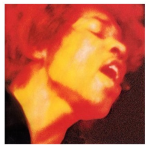 “The Who knew how good Jimi was and wouldn’t be outdone, so they blew the entire stage up with bombs and fireballs and things,” said John Phillips. “That’s why Jimi burned up his guitar and made love to his amp.” Footage from the films Jimi Hendrix: Live at Monterey and Monterey Pop show him humping his guitar and amplifier, playing with his teeth, and finally setting the guitar on fire.
“The Who knew how good Jimi was and wouldn’t be outdone, so they blew the entire stage up with bombs and fireballs and things,” said John Phillips. “That’s why Jimi burned up his guitar and made love to his amp.” Footage from the films Jimi Hendrix: Live at Monterey and Monterey Pop show him humping his guitar and amplifier, playing with his teeth, and finally setting the guitar on fire.
Eric Burden: “This was really the first time Jimi had the chance to play to his own people. So he just went for it.”
David Crosby: “We all sat there with our jaws dropped. We couldn’t believe anybody could do that. Nobody had ever seen or heard anybody play guitar like that before.”
Check out the Jimi Hendrix site.
“Sittin’ on) The Dock of the Bay” (Redding/Cropper) by Otis Redding
Otis Redding composed this song after leaving Monterey Pop and going to San Francisco. He died shortly thereafter. The song is supposed to be a reflection of Redding’s new experiences and experimentation with the rock sound, directly affected by Monterey Pop. At the festival, Redding anchored the Memphis sound with Booker T. the MGs.
Booker T. Jones: “Otis melded the blues style with the Sam Cooke style and the Little Richard style. All those styles were there in Otis. No other singer did that.”
“I was proud to share the same stage with Otis,” said David Crosby. “He was so wonderful, so strong, like some force of nature.”
Lou Adler: “Otis just transported the entire audience to church. They became the congregation, and he was the preacher.”
Bob Weir: “I was pretty sure that I’d just seen God onstage.”
The Monterey Pop Festival Line-up
Friday Evening, June 16: The Association, the Paupers, Lou Rawls, Beverly, Johnny Rivers, Eric Burdon & the Animals.
Saturday Afternoon, June 17: Canned Heat, Big Brother & the Holding Company, Country Joe & the Fish, Al Kooper, the Butterfield Blues Band, Quicksilver Messenger Service, the Steve Miller Band, the Electric Flag.
Saturday Evening, June 17: Moby Grape, Hugh Masekela, the Byrds, the Butterfield Blues Band, Laura Nyro, Jefferson Airplane, Booker T & the MGs with the Mar-Keys, Otis Redding.
Sunday Afternoon, June 18: Ravi Shankar
Sunday Evening, June 18: The Blues Project, Big Brother & the Holding Company, the Group With No Name, Buffalo Springfield, the Who, the Grateful Dead, the Jimi Hendrix Experience, Scott McKenzie, the Mamas & the Papas.
For the songs in my playlist, see below.
Overall Copyright -(c) 1996-2018 by Tony Bove (for Rockument.com). Individual art, music, and video clips are copyrighted by their respective owners.
